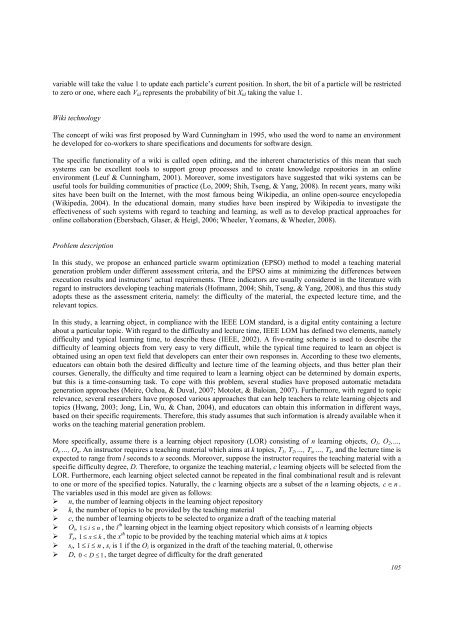Download Complete Issue in PDF - Educational Technology & Society
Download Complete Issue in PDF - Educational Technology & Society
Download Complete Issue in PDF - Educational Technology & Society
You also want an ePaper? Increase the reach of your titles
YUMPU automatically turns print PDFs into web optimized ePapers that Google loves.
variable will take the value 1 to update each particle’s current position. In short, the bit of a particle will be restricted<br />
to zero or one, where each Vid represents the probability of bit Xid tak<strong>in</strong>g the value 1.<br />
Wiki technology<br />
The concept of wiki was first proposed by Ward Cunn<strong>in</strong>gham <strong>in</strong> 1995, who used the word to name an environment<br />
he developed for co-workers to share specifications and documents for software design.<br />
The specific functionality of a wiki is called open edit<strong>in</strong>g, and the <strong>in</strong>herent characteristics of this mean that such<br />
systems can be excellent tools to support group processes and to create knowledge repositories <strong>in</strong> an onl<strong>in</strong>e<br />
environment (Leuf & Cunn<strong>in</strong>gham, 2001). Moreover, some <strong>in</strong>vestigators have suggested that wiki systems can be<br />
useful tools for build<strong>in</strong>g communities of practice (Lo, 2009; Shih, Tseng, & Yang, 2008). In recent years, many wiki<br />
sites have been built on the Internet, with the most famous be<strong>in</strong>g Wikipedia, an onl<strong>in</strong>e open-source encyclopedia<br />
(Wikipedia, 2004). In the educational doma<strong>in</strong>, many studies have been <strong>in</strong>spired by Wikipedia to <strong>in</strong>vestigate the<br />
effectiveness of such systems with regard to teach<strong>in</strong>g and learn<strong>in</strong>g, as well as to develop practical approaches for<br />
onl<strong>in</strong>e collaboration (Ebersbach, Glaser, & Heigl, 2006; Wheeler, Yeomans, & Wheeler, 2008).<br />
Problem description<br />
In this study, we propose an enhanced particle swarm optimization (EPSO) method to model a teach<strong>in</strong>g material<br />
generation problem under different assessment criteria, and the EPSO aims at m<strong>in</strong>imiz<strong>in</strong>g the differences between<br />
execution results and <strong>in</strong>structors’ actual requirements. Three <strong>in</strong>dicators are usually considered <strong>in</strong> the literature with<br />
regard to <strong>in</strong>structors develop<strong>in</strong>g teach<strong>in</strong>g materials (Hofmann, 2004; Shih, Tseng, & Yang, 2008), and thus this study<br />
adopts these as the assessment criteria, namely: the difficulty of the material, the expected lecture time, and the<br />
relevant topics.<br />
In this study, a learn<strong>in</strong>g object, <strong>in</strong> compliance with the IEEE LOM standard, is a digital entity conta<strong>in</strong><strong>in</strong>g a lecture<br />
about a particular topic. With regard to the difficulty and lecture time, IEEE LOM has def<strong>in</strong>ed two elements, namely<br />
difficulty and typical learn<strong>in</strong>g time, to describe these (IEEE, 2002). A five-rat<strong>in</strong>g scheme is used to describe the<br />
difficulty of learn<strong>in</strong>g objects from very easy to very difficult, while the typical time required to learn an object is<br />
obta<strong>in</strong>ed us<strong>in</strong>g an open text field that developers can enter their own responses <strong>in</strong>. Accord<strong>in</strong>g to these two elements,<br />
educators can obta<strong>in</strong> both the desired difficulty and lecture time of the learn<strong>in</strong>g objects, and thus better plan their<br />
courses. Generally, the difficulty and time required to learn a learn<strong>in</strong>g object can be determ<strong>in</strong>ed by doma<strong>in</strong> experts,<br />
but this is a time-consum<strong>in</strong>g task. To cope with this problem, several studies have proposed automatic metadata<br />
generation approaches (Meire, Ochoa, & Duval, 2007; Motolet, & Baloian, 2007). Furthermore, with regard to topic<br />
relevance, several researchers have proposed various approaches that can help teachers to relate learn<strong>in</strong>g objects and<br />
topics (Hwang, 2003; Jong, L<strong>in</strong>, Wu, & Chan, 2004), and educators can obta<strong>in</strong> this <strong>in</strong>formation <strong>in</strong> different ways,<br />
based on their specific requirements. Therefore, this study assumes that such <strong>in</strong>formation is already available when it<br />
works on the teach<strong>in</strong>g material generation problem.<br />
More specifically, assume there is a learn<strong>in</strong>g object repository (LOR) consist<strong>in</strong>g of n learn<strong>in</strong>g objects, O1, O2,…,<br />
Oi,…, On. An <strong>in</strong>structor requires a teach<strong>in</strong>g material which aims at k topics, T1, T2,…, Tx,…, Tk, and the lecture time is<br />
expected to range from l seconds to u seconds. Moreover, suppose the <strong>in</strong>structor requires the teach<strong>in</strong>g material with a<br />
specific difficulty degree, D. Therefore, to organize the teach<strong>in</strong>g material, c learn<strong>in</strong>g objects will be selected from the<br />
LOR. Furthermore, each learn<strong>in</strong>g object selected cannot be repeated <strong>in</strong> the f<strong>in</strong>al comb<strong>in</strong>ational result and is relevant<br />
to one or more of the specified topics. Naturally, the c learn<strong>in</strong>g objects are a subset of the n learn<strong>in</strong>g objects, c ∈ n .<br />
The variables used <strong>in</strong> this model are given as follows:<br />
n, the number of learn<strong>in</strong>g objects <strong>in</strong> the learn<strong>in</strong>g object repository<br />
k, the number of topics to be provided by the teach<strong>in</strong>g material<br />
c, the number of learn<strong>in</strong>g objects to be selected to organize a draft of the teach<strong>in</strong>g material<br />
Oi, 1 ≤ i ≤ n , the i th learn<strong>in</strong>g object <strong>in</strong> the learn<strong>in</strong>g object repository which consists of n learn<strong>in</strong>g objects<br />
Tx, 1 ≤ x ≤ k , the x th topic to be provided by the teach<strong>in</strong>g material which aims at k topics<br />
si, ≤ i ≤ n<br />
1 , si is 1 if the Oi is organized <strong>in</strong> the draft of the teach<strong>in</strong>g material, 0, otherwise<br />
D, 0 < D ≤ 1,<br />
the target degree of difficulty for the draft generated<br />
105

















